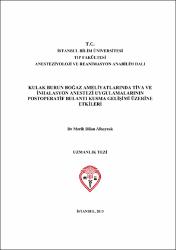| dc.contributor.advisor | Özata, A. Sanem | en_US |
| dc.contributor.author | Albayrak, Merih Dilan | |
| dc.date.accessioned | 2014-06-06T12:45:46Z | |
| dc.date.available | 2014-06-06T12:45:46Z | |
| dc.date.issued | 2013-06-17 | |
| dc.date.submitted | 2013 | |
| dc.identifier.citation | Albayrak, Merih Dilan. (2013). Kulak Burun Boğaz Ameliyatlarında Tiva Ve İnhalasyon Anestezi Uygulamalarının Postoperatif Bulantı Kusma Gelişimi Üzerine Etkileri. Yayımlanmamış doktora tezi. İstanbul : İstanbul Bilim Üniversitesi, Tıp Fakültesi. | en_US |
| dc.identifier.uri | https://hdl.handle.net/11446/99 | en_US |
| dc.description | 17.06.2015 tarihine kadar kullanımı yazar tarafından kısıtlanmıştır. | en_US |
| dc.description | İstanbul Bilim Üniversitesi, Tıp Fakültesi, Anesteziyoloji ve Reanimasyon Anabilim Dalı | en_US |
| dc.description.abstract | Postoperatif Bulantı Kusma (POBK) genel anestezi sonrası hastaya verdiği rahatsızlığın yanında hastanede kalış süresini, hastalığın düzelmesini ve derlenme zamanını da uzatan ciddi bir sorun olmaya devam etmektedir.
Biz çalışmamızda günlük pratikte sıklıkla uygulanan Kulak Burun Boğaz (KBB) girişimlerinde, inhalasyon anestezisi ve Total İntravenöz Anestezi (TİVA) yöntemlerinin, farklı profilaktik antiemetik ajanlar da ekleyerek, POBK üzerine etkilerini araştırdık.
Çalışmaya, aydınlatılmış onam formu alındıktan sonra, KBB ameliyatı yapılması planlanan, ASA I-II risk grubu, 18-55 yaş arası, POBK için bilinen risk faktörlerinden en az birinin mevcut olduğu toplam 120 hasta dahil edildi.
Çalışmaya dahil edilen hastalar randomize edilerek Grup 1 (TİVA), Grup 2 (TİVA-Deksametazon), Grup 3 (TİVA-Ondansetron), Grup 4 (Sevofluran), Grup 5 (Sevofluran-Deksametazon), Grup 6 (Sevofluran-Ondansetron) adıyla altı gruba ayrıldı.
Anestezi indüksiyonu 1 mcg/kg Fentanyl, 2 mg/kg Propofol, 0,5 mg/kg Atrakuryum ile gerçekleştirildi.
Grup 1, 2 ve 3’te yer alan hastaların anestezi idamesi 0,1 mg/kg/dk Propofol, 0,2 mcg/kg/dk Remifentanil kullanılarak TİVA ile sağlandı.
Grup 4, 5 ve 6’da yer alan hastaların anestezi idamesi %2 Sevofluran ile oksijen-hava (%50-%50) ve 0,2 mcg/kg/dk Remifentanil infüzyonu ile sağlandı.
Grup 2 ve 5’te yer alan hastalara indüksiyondan hemen sonra 8 mg Deksametazon iv yolla uygulandı. Grup 3 ve 6’da yer alan hastalara ameliyat bitiminden önce 4 mg Ondansetron iv yolla uygulandı.
Hastalara cerrahi bitiminde postoperatif analjezinin sağlanması amacıyla opioid türevi ilaçlar uygulanmadı. Deksketoprofen veya Tenoksikam ve gerektiğinde parasetamol tercih edildi.
Hastalar postoperatif 0-2 saat, 2-6 saat, 6-24 saat ( taburculuk sonrası ) aralıklarında olmak üzere toplam 24 saat boyunca POBK yönünden değerlendirildi. Taburculuk sonrası tüm hastalara telefon edilerek POBK şiddeti sorgulandı. Olgulardaki POBK şiddeti dört aşamalı verbal deskriptif skala (VDS) ile belirlendi.
Çalışmamızda, KBB girişimlerinde, propofol ve remifentanil ile TİVA uygulaması tercih edildiğinde, POBK’nın önlenmesi için profilaktik antiemetik gerekmediği sonucuna vardık. Anestezi idamesinin Sevofluran ile sağlandığı durumlarda ise profilaktik Ondansetron uygulanması ile POBK yeterli ölçüde önlenebilir. | en_US |
| dc.description.abstract | Comparison between total intravenous anesthesia and inhalation anesthesia in ENT surgery: postoperative nausea and vomiting
Postoperative nause and vomiting (PONV) is still a common problem of anesthesia including delayed discharge and recovery time.
In our study we compared total intravenous anesthesia with propofol-remifentanyl and inhalation anesthesia with sevoflurane preventing PONV in Ear Nose Throat (ENT) surgery. We used two different prophylactic antiemetics in order to find out the most adequate modality to prevent PONV
After informed consent was obtained, 120 patients ASA I-II class between 18-55 years undergoing ENT surgery including at least one risc factor for PONV were enrolled in the study.
Patients were randomized to 6 groups as Grup 1 (TIVA), Grup 2 (TIVA-Dexamethasone), Grup 3 (TIVA-Ondansetron), Grup 4 (Sevoflurane), Grup 5 (Sevoflurane-Dexamethasone), Grup 6 (Sevoflurane-Ondansetron) .
For induction of anestesia 1 mcg/kg Fentanyl, 2 mg/kg Propofol, 0,5 mg/kg Atracurium were used to all patients.
Maintenance of anesthesia in group 1, 2 and 3 was performed with TIVA using 0,1 mg/kg/min Propofol and iv 0,2 mcg/kg/min Remifentanyl.
Maintenance of anesthesia in group 4, 5 and 6 was achieved with %2 Sevoflurane, oxygen and air mixture (%50-%50) and 0,2 mcg/kg/min Remifentanyl infusion.
Dexamethasone 8 mg iv was administered immediately after induction to the patients in Group 2 and 5. Ondansetron 4 mg iv was administered at the end of the surgery to the patients in Group 3 and 6.
To provide postoperative analgesia Dexcetoprophen or Tenoksicam was administered and also Parasetamol if needed. Opioid derivative drugs were not used in any groups.
PONV was recorded in determined time intervals as 0-2, 2-6, 6-24 ( after discharge) hours in patients. All the patients were called by phone after discharge and questioned about PONV severity. PONV severity was determined with verbal descriptive scale. (VDS)
In conclusion, if TIVA using propofol and remifentanyl is preffered in ENT surgery, prophylactic antiemetics are not required for the prevention of PONV. When Sevoflurane is used for maintainance of anaesthesia, iv Ondansetron prophylaxis can adequately prevent PONV. | en_US |
| dc.language.iso | tur | en_US |
| dc.publisher | İstanbul Bilim Üniversitesi, Tıp Fakültesi. | en_US |
| dc.rights | info:eu-repo/semantics/embargoedAccess | en_US |
| dc.subject | anestezi-inhalasyon | en_US |
| dc.subject | anestezi-intravenöz | en_US |
| dc.subject | anesteziden ayılma dönemi | en_US |
| dc.subject | bulantı | en_US |
| dc.subject | postoperatif komplikasyonlar | en_US |
| dc.subject | anesthesia-inhalation | en_US |
| dc.subject | anesthesia-intravenous | en_US |
| dc.subject | anesthesia recovery period | en_US |
| dc.subject | nausea | en_US |
| dc.subject | postoperative period | en_US |
| dc.subject | postoperative complications | en_US |
| dc.subject | cerrahi-kulak-burun-boğaz | en_US |
| dc.subject | surgery-otorhinolaryngologic | en_US |
| dc.subject | kusma | en_US |
| dc.subject | vomiting | en_US |
| dc.title | Kulak burun boğaz ameliyatlarında tiva ve inhalasyon anestezi uygulamalarının postoperatif bulantı kusma gelişimi üzerine etkileri | en_US |
| dc.title.alternative | Comparison between total intravenous anesthesia and inhalation anesthesia in ent surgery: postoperative nausea and vomiting | en_US |
| dc.type | doctoralThesis | en_US |
| dc.department | DBÜ, Tıp Fakültesi | en_US |
| dc.contributor.authorID | TR145711 | en_US |
| dc.contributor.authorID | TR141526 | en_US |
| dc.relation.publicationcategory | Tez | en_US |


















